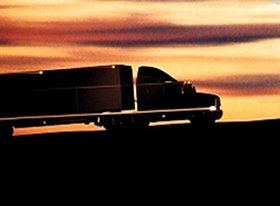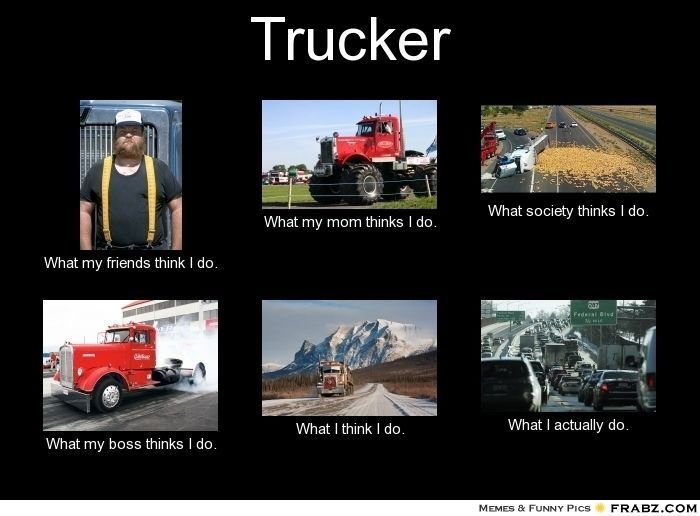Stupid 14 Hour Clock
Topic 17985 | Page 1
Waaaahll..
Welcome To Trucking...
Rick
Learn to get loaded and unloaded when you are off the clock. Sleeping at the shipper/receiver is one of the best ways to avoid it. Obviously it doesn't always work out, but I try to when I can. Welcome to trucking. Hurry up and wait.
Shipper:
The customer who is shipping the freight. This is where the driver will pick up a load and then deliver it to the receiver or consignee.
Paid detention? Send the macro go to sleep, get paid to sleep. Wake up, get paid to drive...
Rinse and repeat.
Bryan, I remember a quote from somewhere in my foggy memory that went something like this: "Time flies... But at least you are the pilot."
What I am trying to point out is that you have got to learn to manage it no matter what the shipper/receiver pulls on you.
I have to assume that you are just getting started at this, because that is a problem that most rookies run into.
There are several ways to deal with issues like this. One is to learn how to maximize your driving hours by understanding the split sleeper rules. Here's an example:
I used to often times go to a shipper in Connecticut that regularly took six hours to load me. I would do one of two things when I was going there.
1) I would sleep across the street in a vacant parking lot so that I could roll into their property when they opened the gate in the morning. That way I didn't even have my clock running while they were loading me. When they finally got finished I still had a full day ahead of me to roll.
2) If I couldn't work that out I would just show up and get myself on the sleeper berth line until they were finished. That way if I stayed there parked on their place for just two more hours my fourteen hour clock would be paused and I would have the same amount of time that I had when I first arrived there.
That second option is the split sleeper rule. You can learn all about it by working your way through the section for logs in our High Road Training Program.
CDL:
Commercial Driver's License (CDL)
A CDL is required to drive any of the following vehicles:
- Any combination of vehicles with a gross combined weight rating (GCWR) of 26,001 or more pounds, providing the gross vehicle weight rating (GVWR) of the vehicle being towed is in excess of 10,000 pounds.
- Any single vehicle with a GVWR of 26,001 or more pounds, or any such vehicle towing another not in excess of 10,000 pounds.
- Any vehicle, regardless of size, designed to transport 16 or more persons, including the driver.
- Any vehicle required by federal regulations to be placarded while transporting hazardous materials.
Shipper:
The customer who is shipping the freight. This is where the driver will pick up a load and then deliver it to the receiver or consignee.
Sleeper Berth:
The portion of the tractor behind the seats which acts as the "living space" for the driver. It generally contains a bed (or bunk beds), cabinets, lights, temperature control knobs, and 12 volt plugs for power.

Awesome sauce thanks to all of you very much for your helpful Post's
Bryan, I remember a quote from somewhere in my foggy memory that went something like this: "Time flies... But at least you are the pilot."
What I am trying to point out is that you have got to learn to manage it no matter what the shipper/receiver pulls on you.
I have to assume that you are just getting started at this, because that is a problem that most rookies run into.
There are several ways to deal with issues like this. One is to learn how to maximize your driving hours by understanding the split sleeper rules. Here's an example:
I used to often times go to a shipper in Connecticut that regularly took six hours to load me. I would do one of two things when I was going there.
1) I would sleep across the street in a vacant parking lot so that I could roll into their property when they opened the gate in the morning. That way I didn't even have my clock running while they were loading me. When they finally got finished I still had a full day ahead of me to roll.
2) If I couldn't work that out I would just show up and get myself on the sleeper berth line until they were finished. That way if I stayed there parked on their place for just two more hours my fourteen hour clock would be paused and I would have the same amount of time that I had when I first arrived there.
That second option is the split sleeper rule. You can learn all about it by working your way through the section for logs in our High Road Training Program.
CDL:
Commercial Driver's License (CDL)
A CDL is required to drive any of the following vehicles:
- Any combination of vehicles with a gross combined weight rating (GCWR) of 26,001 or more pounds, providing the gross vehicle weight rating (GVWR) of the vehicle being towed is in excess of 10,000 pounds.
- Any single vehicle with a GVWR of 26,001 or more pounds, or any such vehicle towing another not in excess of 10,000 pounds.
- Any vehicle, regardless of size, designed to transport 16 or more persons, including the driver.
- Any vehicle required by federal regulations to be placarded while transporting hazardous materials.
Shipper:
The customer who is shipping the freight. This is where the driver will pick up a load and then deliver it to the receiver or consignee.
Sleeper Berth:
The portion of the tractor behind the seats which acts as the "living space" for the driver. It generally contains a bed (or bunk beds), cabinets, lights, temperature control knobs, and 12 volt plugs for power.

Old School says it best. In planning your trip, assume a certain amount of time needed at the stop, and plan accordingly.
The Split Sleeper technique works, but it's a lot like a card trick: to you it's amazing "your" card appears at the top of the deck, but to other magicians it's just more entertainment.


The Split Sleeper technique works, but it's a lot like a card trick: to you it's amazing "your" card appears at the top of the deck, but to other magicians it's just more entertainment.
As someone who used to be a professional magician, I concur.
The Split Sleeper technique works, but it's a lot like a card trick: to you it's amazing "your" card appears at the top of the deck, but to other magicians it's just more entertainment.
As someone who used to be a professional magician, I concur.
I used to be a professional magician also. Many moons ago.
New Reply:
New! Check out our help videos for a better understanding of our forum features

















Preview:








 TT On Facebook
TT On Facebook
I find it very much annoying to be @ a shipper or consignee and being on the good ole eobr or electronic logs you know you clock off duty and it ****es me off that you can't stop your 14 hour clock even when your sitting waiting to get loaded I.e. live load or your waiting to get unloaded and the shipper or consignee takes there sweet time and burns up your freaking clock reSulting in less miles you can drive there should be some kind of law that they HAVE a time frame to unload or load you and not waste all your time they have never drove a truck or do they understand the rules that us truckers have to follow.......
Consignee:
The customer the freight is being delivered to. Also referred to as "the receiver". The shipper is the customer that is shipping the goods, the consignee is the customer receiving the goods.
EOBR:
Electronic Onboard Recorder
Electronic Logbook
A device which records the amount of time a vehicle has been driven. If the vehicle is not being driven, the operator will manually input whether or not he/she is on duty or not.
Electronic Logs:
Electronic Onboard Recorder
Electronic Logbook
A device which records the amount of time a vehicle has been driven. If the vehicle is not being driven, the operator will manually input whether or not he/she is on duty or not.
Shipper:
The customer who is shipping the freight. This is where the driver will pick up a load and then deliver it to the receiver or consignee.